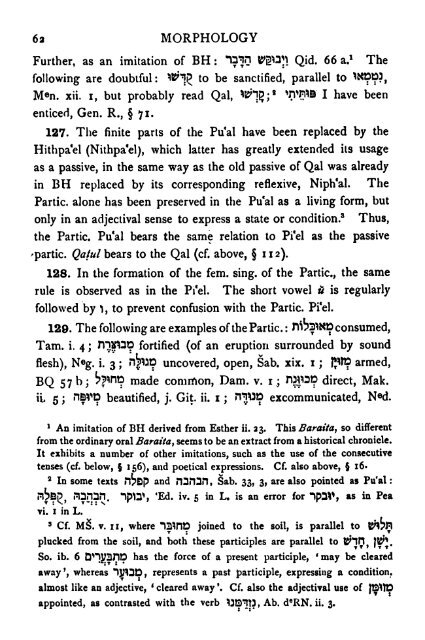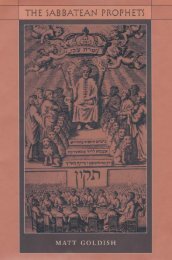A Grammar of Mishnaic Hebrew
A Grammar of Mishnaic Hebrew
A Grammar of Mishnaic Hebrew
You also want an ePaper? Increase the reach of your titles
YUMPU automatically turns print PDFs into web optimized ePapers that Google loves.
63 MORPHOLOGY<br />
Further, as an imitation <strong>of</strong> BH: "ID^n Qid. 66 a.* The<br />
following are doubtful: ^^"^^ to be sanctified, parallel to ^^^D^?*<br />
M«n. xii. I, but probably read Qal, ^n^n^a I have been<br />
enticed. Gen. R., § 71.<br />
127. The finite parts <strong>of</strong> the Pual have been replaced by the<br />
Hithpael (Nithpa'el), which latter has greatly extended its usage<br />
as a passive, in the same way as the old passive <strong>of</strong> Qal was already<br />
in BH replaced by its corresponding reflexive, Niph'al. The<br />
Partic. alone has been preserved in the Pu al as a living form, but<br />
only in an adjectival sense to express a state or condition.' Thus,<br />
the Partic, Pual bears the same relation to Pi'el as the passive<br />
^partic. Qaful bears to the Qal (cf. above, § 112).<br />
128. In the formation <strong>of</strong> the fem. sing, <strong>of</strong> the Partic, the same<br />
rule is observed as in the Pi'el. The short vowel u is regularly<br />
followed by 1, to prevent confusion with the Partic. Pi'el.<br />
129. The following are examples <strong>of</strong> the Partic: Hi^S^KD consumed,<br />
Tam. i. 4; H'Jjnso fortified (<strong>of</strong> an eruption surrounded by sound<br />
flesh), N«g. i. 3; H^^ilD uncovered, open. Sab. xix. i ; p t D armed,<br />
BQ 57 b; h}^XiD made common. Dam. v. i; ^^iP^ direct, Mak.<br />
ib 5; HBVlp beautified, j. Git. ii. i ; HTOD excommunicated, N®d.<br />
' An imitation <strong>of</strong> BH derived from Esther ii. 23. This Baraita, so different<br />
from the ordinary oral Baraita, seems to be an extract from a historical chronicle.<br />
It exhibits a number <strong>of</strong> other imitations, such as the use <strong>of</strong> the constecutive<br />
tenses (cf. below, $ 156), and poetical expressions. Cf. also above, $ 16.<br />
* In some texts H^Dp and nan3n, Sab. 33, 3, are also pointed as Pu'al:<br />
nbap, ririnan. "^pUS 'Ed. iv. 5 in L. is an error for ip3V, as in Pea<br />
vi. I in L.<br />
» Cf. M§. V. II, where na^HD joined to the soil, is parallel to<br />
plucked from the soil, and both these participles are parallel to ^^J,<br />
So. ib. 6 Dnyanp has the force <strong>of</strong> a present participle, 'may be cleared<br />
away*, whereas "^i^QlD, represents a past participle, expressing a condition,<br />
almost like an adjective, * cleared away *. Cf. also the adjectival use <strong>of</strong> JDW<br />
appointed, as contrasted with the verb ^3tp^p, Ab. d^RN. ii. 3.











